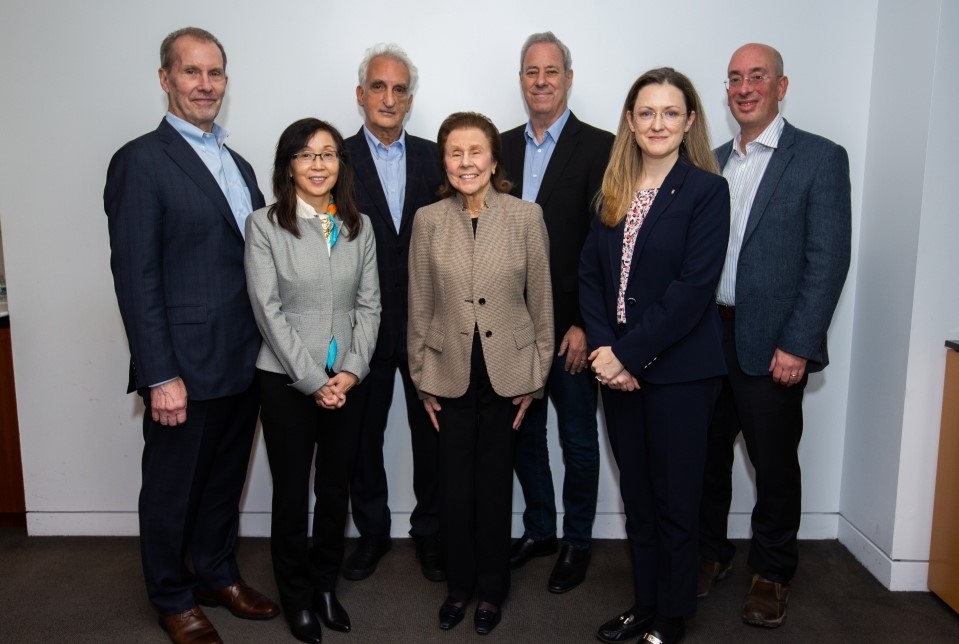The 11th annual Appel Alzheimer’s Disease Research Institute Symposium brought together leading scientists and clinicians in the field to present the latest advances in understanding Alzheimer’s and related neurodegenerative diseases. The event was held at the Belfer Research Building on Nov. 9.
Helen and Robert Appel established the Institute in 2006 after they lost close friends to Alzheimer’s. “I am hopeful that we are closer than ever to a meaningful cure for this terrible disease. That’s why events like today’s which bring together the scientific community to exchange ideas are so vital to making progress,” said Helen Appel.
Dr. Francis Lee, chair of the Department of Psychiatry at Weill Cornell Medicine, opened with a tribute to Robert Appel, who passed last year. “He embraced Weill Cornell’s vision and community spirit and brought it to life through his leadership and personal generosity across two decades,” said Dr. Lee, professor of psychiatry at Weill Cornell Medicine and professor of neuroscience at the Feil Family Brain and Mind Research Institute at Weill Cornell Medicine. “We are here to carry on his enthusiasm for Weill Cornell today and every day through the work of the Appel Institute.”
Appel Institute Director Dr. Li Gan noted, “Here at Weill Cornell Medicine, we are making great progress in developing new therapeutic strategies for neurodegenerative diseases. Over the past year, we have published 22 papers in high impact journals—these discoveries have deepened our understanding of the fundamental mechanisms in Alzheimer’s, Parkinson’s disease and frontotemporal dementia.” Most notably, two ongoing clinical trials are based on discoveries made at the Appel Institute, added Dr. Gan, who is also the Burton P. and Judith B. Resnick Distinguished Professor in Neurodegenerative Diseases in the Feil Family Brain and Mind Research Institute at Weill Cornell Medicine.
Roughly six million Americans are currently diagnosed with Alzheimer’s disease (AD), which progressively destroys cognitive function and memory, and the majority are not treated. But there was an air of excitement and hope at the symposium as the researchers noted that the last three decades of basic and clinical findings have led to the first new disease-modifying treatments to dramatically reduce amyloid plaques in the brain, one of the characteristic microscopic abnormalities found in people with AD. This new class of anti-amyloid immunotherapies has slowed the clinical progression of Alzheimer’s over 18 months by about 30 percent.
Strides in Understanding Mechanisms Underlying Disease
Dr. James Surmeier, chair of the Department of Neuroscience and the Nathan Smith Davis Professor at Northwestern University Feinberg School of Medicine, discussed his work on the mechanisms underlying why dopaminergic neurons in the brain die, leading to Parkinson’s disease (PD). These neurons live in the substantia nigra, a critical brain region that produces dopamine, the neurotransmitter necessary for movement control, cognitive executive functions and limbic activity that governs emotions.
His research has shown that the unique structure of dopaminergic neurons creates a bioenergetic burden which results in elevated oxidant stress that damages mitochondria, the energy producing centers inside cells. This helps explain the loss of mitochondrial function in dopaminergic neurons and the selective death of the neurons with aging. The result is the cardinal motor symptoms of PD such as tremors and slow movement. The discovery has led to a major Phase 3 clinical trial in North America to determine the ability of a new drug to slow the progression of early-stage PD.
Switching gears, Dr. Anna G. Orr, the Nan and Stephen Swid Assistant Professor of Frontotemporal Dementia Research and an assistant professor of neuroscience in the Brain and Mind Research Institute at Weill Cornell Medicine, discussed how astrocytes affect cognitive function. While many researchers focus on neurons, Dr. Orr and her team investigate how astrocytes, which critically support and regulate neurons, influence dementia and could be targeted with novel therapeutics. Dr. Orr discussed her lab’s discoveries that impairments in astrocytes, such as malfunction in their receptors and neuroimmune pathways, can instigate cognitive decline in experimental models. These studies have major relevance for AD and frontotemporal dementia, which have prominent changes in astrocytes. The team also studies how mitochondrial production of free radicals affects astrocytes and neurodegenerative disease. Dr. Orr’s lab is developing highly precise therapeutics to suppress harmful increases in free radicals.
Clinical Advances
Moving on to clinical aspects of Alzheimer’s research, Dr. Eric M. Reiman, chief executive officer of Banner Research, explored how current anti-amyloid immunotherapies, approved by the United States Food and Drug Administration (FDA) this year, may be used in the next three to five years to slow or even block Alzheimer’s before symptoms appear. Dr. Reiman suggested that these treatments could also work for prevention and have a more profound effect if they’re started before pathology ensues. But first researchers will need to find biomarkers, biological data that a person is likely to get Alzheimer’s. Dr. Reiman discussed research that could lead to screening a large number of individuals with an inexpensive, scalable test rather than the expensive imaging tests, such as PET scans, currently used. He sees the field moving toward blood tests that can detect the hallmarks of Alzheimer’s disease such as amyloid, tau protein tangles and inflammation.
In the closing talk, Adam L. Boxer, the Endowed Professor in Memory and Aging in the Department of Neurology at the Weill Institute for Neurosciences at University of California, San Francisco, discussed the need for next generation clinical trials for neurodegenerative diseases. “The rate limiting step for developing new Alzheimer’s immunotherapies has been the conduct of clinical trials,” said Dr. Boxer. He also emphasized the need to develop better biomarkers of disease to understand how they relate to clinical benefits and biological effects of new drugs.
Researchers are now starting new studies called platform (umbrella) trials that enable faster and more efficient evaluation of new disease-modifying therapies. Traditionally, clinical trials test one drug at a time, by dividing participants into two groups: one that receives the drug and another that receives a placebo. These expensive trials take years and require many patients to enroll. Platform trials are designed so that multiple targeted therapies can be evaluated in a single disease setting. So, instead of just one drug being tested in a trial, multiple drugs, either alone or in combination, are tested as sub trials within the larger trial setting. This type of design can reduce the cost and amount of time to test a single treatment approach by up 50 percent or more and are much more favorable for participants because fewer people receive placebo.
The researchers at the symposium agreed that we are now at the turning point that may lead to treatments for millions within the next three to five years. While the reality of this is yet to be seen, there is now more reason to hope than ever before.
Source : Well Corner Meddecine
















